Curvelo Here are some heartwarming stats from last year’s mega elections that may restore your faith in humanity and/or blow your mind.
Algete 1) 73% of voters in Vadodra or 8.45 lakh people voted for Narendra Modi
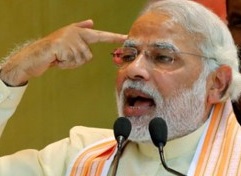
It’s no surprise that some of the most impressive victories in the election were seen in the state of Gujarat by BJP candidates. Narendra Modi’s victory in Vadodara was arguably the most comprehensive one across India. Modi and C.R. Patil (Navsari, Gujarat – BJP) are the only ones who made it to the to top-5 of both the ‘maximum absolute votes’ list as well as ‘maximum percentage votes’ list.
Here are the top 5 candidates who received the maximum absolute number of votes in the Lok Sabha 2014 elections:
|
Parliamentary |
Name Of State/ |
Candidate |
Total |
Party |
|
Jaipur |
Rajasthan |
Ramcharan Bohara |
8.63 lakhs |
BJP |
|
Indore |
Madhya Pradesh |
Sumitra |
8.55 lakhs |
BJP |
|
Vadodara |
Gujarat |
Narendra Modi |
8.45 lakhs |
BJP |
|
Navsari |
Gujarat |
C. R. Patil |
8.21 lakhs |
BJP |
|
Gandhinagar |
Gujarat |
L.K.Advani |
7.72 lakhs |
BJP |
Here are the top 5 candidates who received the maximum percentage of votes in their constituencies in the Lok Sabha 2014 elections:
|
Parliamentary |
Name Of State/ |
Candidate |
% of total votes polled |
Party |
|
Surat |
Gujarat |
Darshana Vikram Jardosh |
76% |
BJP |
|
Vadodara |
Gujarat |
Narendra Modi |
73% |
BJP |
|
Navsari |
Gujarat |
C. R. Patil |
71% |
BJP |
|
Mumbai North |
Maharashtra |
Gopal Chinayya Shetty |
70% |
BJP |
|
Nagaland |
Nagaland |
Neiphiu Rio |
69% |
Naga People’s Front |
2) Thupstan Chhewang from Ladakh won by only 36 votes
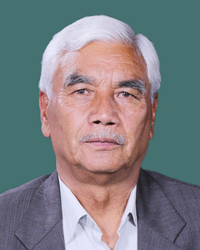
One criticism of India’s electoral system is the ‘first past the post system’, that allows the candidate with most votes (even if they are less than 50%) to be declared the winner. In the case of Ladakh’s Thupstan Chhewang, the victory margin was only 36 votes!
Here are the 5 winning candidates who received the minimum percentage of votes in the Lok Sabha 2014 elections:
|
Parliamentary |
Name Of State/ |
Winning Candidate |
% of total votes polled |
Party |
|
Ladakh |
Jammu & Kashmir |
Thupstan Chhewang |
26% |
BJP |
|
Ludhiana |
Punjab |
Ravneet Singh Bittu |
27% |
Congress |
|
Mahabubabad |
Andhra Pradesh |
Prof. Azmeera Seetaram Naik |
29% |
TRS |
|
Raiganj |
West Bengal |
Md. Salim |
29% |
CPM |
|
Alipurduars |
West Bengal |
Dasrath Tirkey |
30% |
AITC |
3) 63% of winners received less than half of their constituency’s total votes
Continuing with the same theme, only 200 or 37% of Lok Sabha winners received more than 50% of total votes cast in their constituencies. This means that most Lok Sabha MPs won despite a majority of voters not voting for them. This is a common theme in India’s electoral process.
4) 73.2 lakh people voted in just 5 constituencies i.e. more than the populations of Denmark or Ireland or Singapore
The sheer number of people who voted in the Lok Sabha elections is quite staggering, especially in larger constituencies. The constituencies that recorded the 5 most votes (less than 1/100th of total constituencies) had a cumulative voter population that surpassed the populations of many countries.
Here are the top 5 constituencies where most votes were cast.
|
Parliamentary |
Name Of |
Number of |
|
Malkajgiri |
Telengana |
16.2 lakhs |
|
Gauhati |
Assam |
15.1 lakhs |
|
Bangalore Rural |
Karnataka |
14.6 lakhs |
|
Dhubri |
Assam |
13.7 lakhs |
|
Ghatal |
West Bengal |
13.7 lakhs |
Since every constituency has one seat for a Lok Sabha member, the power of a single vote can be different depending on the population of a constituency. The most number of votes were cast in Malkajgiri, Telengana (16.2 lakhs) while the least were cast in Lakshwadeep (43 thousand). Both Malkajgiri and Lakshwadeep sent 1 MP each to the 2014 Lok Sabha.
Here are the 5 constituencies where the least number of votes were cast.
|
Parliamentary Constituency |
Name Of |
Number of |
|
Lakshadweep |
Lakshadweep |
43 thousand |
|
Daman & Diu |
Daman & Diu |
87 thousand |
|
Ladakh |
Jammu & Kashmir |
1.2 lakhs |
|
Dadar & Nagar |
Dadar & Nagar |
1.7 lakhs |
|
Andaman & Nicobar |
Andaman & Nicobar |
1.9 lakhs |
5) Chennai South and Varanasi constituencies had 42 candidates each
The record for most candidates in a single constituency was shared by Chennai South and Varanasi. Here are the constituencies with most candidates:
|
Parliamentary |
Name Of State/ |
Number of Candidates |
Winner |
Party |
|
Chennai South |
Tamil Nadu |
42 |
Dr. J. Jayavardhan |
ADMK |
|
Varanasi |
Uttar Pradesh |
42 |
Narendra |
BJP |
|
Hisar |
Haryana |
41 |
Dushyant Chautala |
Indian National Lok Dal |
|
Chennai North |
Tamil Nadu |
40 |
Venkatesh |
ADMK |
|
Beed |
Maharashtra |
39 |
Munde Gopinathrao Pandurang |
BJP |
The minimum cost of running for elections in India is not much. All candidates submit a deposit of Rs. 25,000 with the Election Commission. This deposit is lost if the candidate does not poll at least 1/6th or 16.67% of the total votes polled. However, this is a small price to pay for the larger political parties who often purposely prop up independent candidates to confuse voters. For instance, say a political party knows that their main opposition candidate is of a certain caste that would attract a lot of votes. The political party would then prop up 3-4 candidates of the same caste to reduce the vote share of the main political opponent. In a simpler way, this can be done with names as well do confuse the voters. Here’s an example from Mahasamund in Chhattisgarh:
Eventually BJP’s Chandu Lal Sahu won but by only 1217 votes over Congress’ Ajit Jogi. So it appears that Jogi’s strategy of propping up independent candidates almost worked.
6) Only 0.093% of all Independent candidates won
The previous point speaks to how many independent candidates are just pawns in the entire setup. However, this stat also shows the immense power that political parties hold in our electoral setup. Just 3 out of 3,235 independent candidates won. Here are the the three special ones.
7) Based on actual vote share, BJP should have won only 168 seats instead of 282
The Lok Sabha elections are actually like 543 mini-elections because of the vast differences between constituencies (populations, # of candidates, SC/ST, regional political parties etc.). A political party from the north may be absent from the south and as discussed earlier, the voting population in one constituency may be one tenth of that in another. Let’s say all the votes cast in the country were counted together and then seats were distributed. In other words, what if the Lok Sabha was formed using vote share across the country. Here’s what would have happened:
Mind blown! Faith in humanity restored!
Source: Election Commission of India
 Copyright secured by Digiprove
Copyright secured by Digiprove
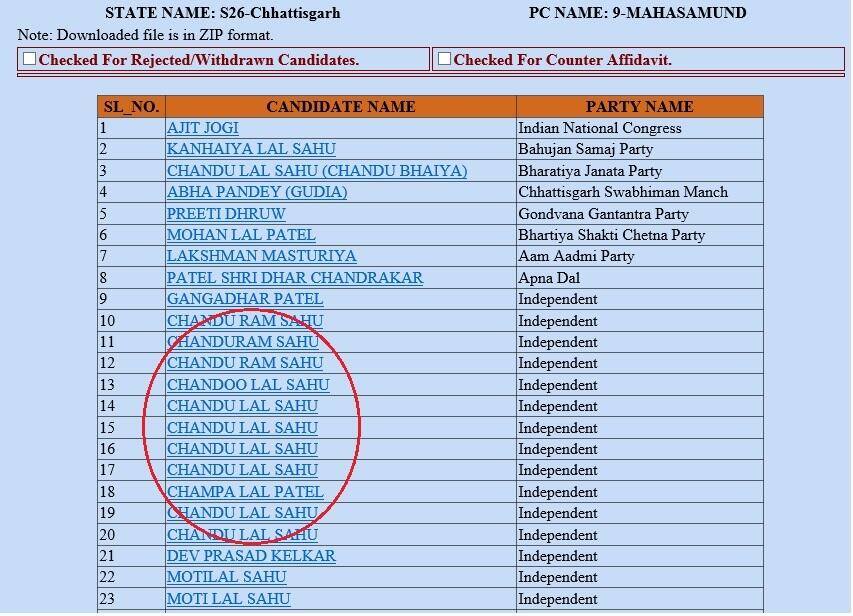

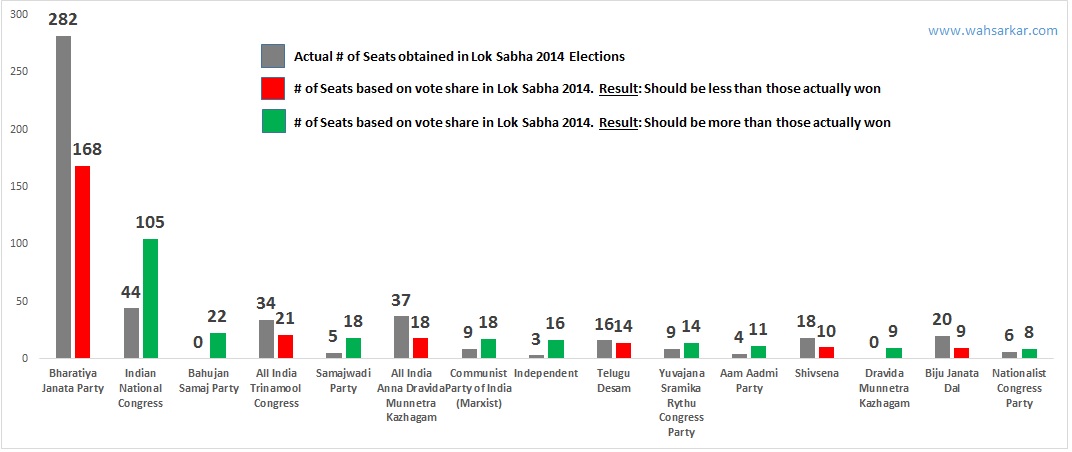
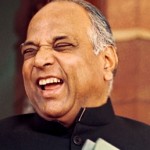
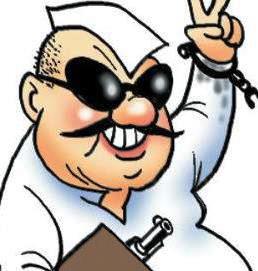
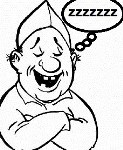
Yes, independent candidates should indeed be banned. Only used by pol parties for their gain.
We should have opted for promotional representative system rather than the first-past-the-post
One issue with that would be that it would completely kill off a lot of state level parties. It would be biased in favour of large parties that are able to field a lot of candidates across the country – like BSP.
Nah. We get to make one choice and that’s enough. It’s impossible to measure how much people value their second and third options and that degree varies for all. In short, first past post is just finee.
mumbai
is one of the most desirable locations in the world . very interesting and
attractive blog and post.. i likes it.. see Gruhkhoj Property
Portal